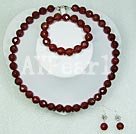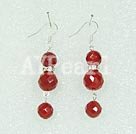Red carnelian was highly valued and used in rings and signets by the Greeks and Romans, some of whose intaglios have retained their high polish better than those made from harder stones.
Discount red carnelian was recovered from Bronze Age Minoan layers at Knossos on Crete in a form that demonstrated its use in decorative arts; this use dates to approximately 1800 BC.
Cheap red carnelian was used widely during Roman times 2000 years before the present era to make signet or seal rings for imprinting a seal with wax on correspondence or other important documents. Hot wax does not stick to Red carnelian.
Handmade red carnelian is mined principally in India, Brazil, and Australia. Its physical properties are those of quartz.
China red carnelian is translucent, semiprecious variety of the silica mineral chalcedony. It owes its red to reddish brown colors according to the incorporation of small amounts of iron oxide. A closely related variety of chalcedony, sard, differs only in the shade of red.
Carnelian, a reddish-brown mineral, is commonly used as a semi-precious gemstone. Similar to carnelian is sard, which is generally harder and darker.
Both red carnelian and sard are varieties of the silica mineral chalcedony colored by impurities of iron oxide. The color can vary greatly, ranging from pale orange to an intense almost-black coloration.
There are some aspects in which fashion red carnelian and sard are different:
Color: red carnelian is lighter with shades ranging from orange to reddish-brow while sard is darker with shades ranging from a deep reddish-brown to almost black.
Hardness: red carnelian is softer and sard is harder and tougher.
Feature: red carnelian is uneven, splintery and conchoidal but sard is like carnelian, but duller and more hackley.
It should be noted that all of these properties vary across a continuum, and so the boundary between carnelian and sard is inevitably blurred.






 Log in
Log in Register
Register










